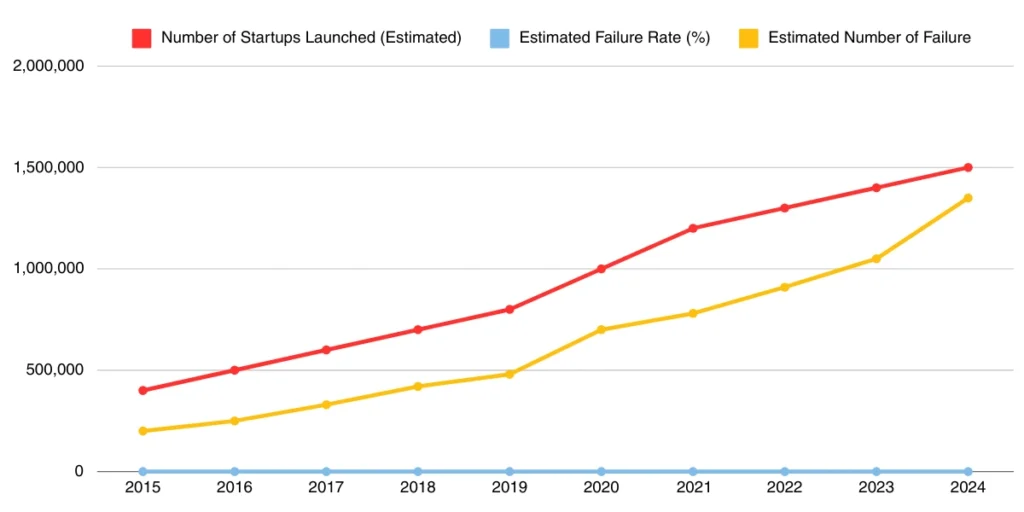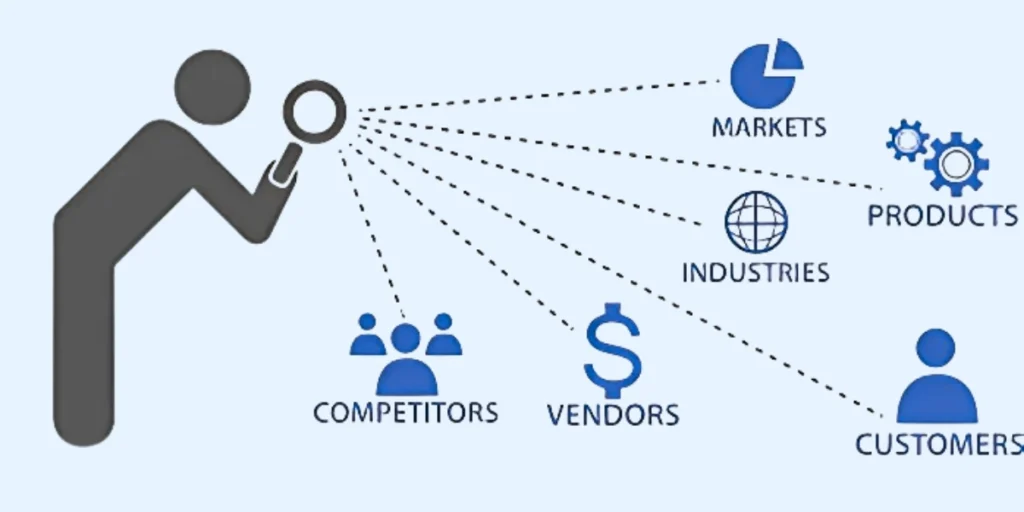The year 2024 marked a significant milestone with the coming into existence of over 305 million startups around the world, a testament to the relentless desire for innovation and determination.
Yet, this colorful ecosystem also had its darkness up to 90% of startups fail in the long run.
This statistic underlines a significant challenge for new business proprietors although everyone wants to succeed, the road to success is paved with obstacles.
The first year is a particularly dangerous time for new businesses, with around 10% failing after just 12 months. In the time that passes, the failure rate soars after year five, and almost 70% of new businesses will be closed.

It sends home yet another reminder of the need to be firmly grounded and in the right direction by hands-on experience-driven experts.
This is where strategic growth advisers add tremendous value. An Entrepreneur Growth Plan would make for a complete roadmap for a business person to sail through every complexity of life down the track on the entrepreneurial road.
A strategic business growth plan differentiates you in the market and provides actionable items to put everything you want into effect when scaling effectively. So if you are a startup looking to establish yourself or an established business looking to increase market share, you need a growth plan or a strategic growth advisor to help you bridge the gap between where you are and where you want to be, which includes the essential steps of the business growth strategy.
Let’s explore what you can do to help your organization achieve sustainable growth, against the odds provided by these ominous statistics.
Table of Contents
ToggleWhy a Strategic Growth Plan is Necessary
Get The Strategy That Your Business Needs!
Vicino’s strategic growth advisors help your business grow with clear strategies, expert insights, and actionable plans tailored for success!
Before jumping to the practices of drafting growth strategies, it is important to understand why organizations need a framework for growth.
Having a clear strategy delivers a host of important advantages:
Direction and Clarity:
Well-defined business goals enable companies to stay focused on their long-term targets. This clarity is critical not just for leaders but for team members throughout the organization. When each person knows what the big picture goals are, they can align their day-to-day work and responsibilities to these goals, creating a sense of accountability and purpose.
Competitive advantage
A well-developed plan for your strategic direction helps businesses distinguish themselves from the competition by recognizing unique selling propositions (USPs) along using them strategically.
In crowded marketplaces, knowing exactly what differentiates you from your competitors can be the difference between success and failure.
That differentiation can be achieved through much whether it be the functionality of your product, the service of your team, or your branding approach.
Resource Optimization
With a roadmap in hand, businesses can leverage their time, capital, and labor much more productively.
By doing so, this optimization ensures that human resources are being utilized in areas possible for it to make the most impact whilst minimizing waste thereby increasing overall productivity.
Strategic growth advisors might perform audits on resources to find places where efficiency could be increased so that businesses can get the most return out of their investments.
Risk Mitigation
By understanding potential challenges and uncertainties, businesses can create contingency plans that minimize risk in the face of market fluctuations and operational barriers.
Early detection of potential threats can be anything from a new recession, a change in the behavior of consumers, or a breakthrough in technology, which is followed with strategic steps to avert them.
It is the strategic growth advisors who will navigate these complex areas as well as offer their experience in proven strategies for growth tailored to each business’s unique context.
Organizations rely on them not just to understand where they need to do better but how they can actually achieve that.
Having Clear Business Goals and Objectives

SMART goals provide the foundation that every successful business is built upon. These goals must be SMART: Specific, Measurable, Achievable, Relevant, and Timely.
Specific: Goals should be clearly defined and unambiguous. Vague goals lead to confusion and lack of direction therefore, specificity is key in ensuring everyone understands what needs to be accomplished.
Measurable: Goals need a measurement to determine if you have reached them. Hitting a vague target creates confusion and lack of direction on all sides, specificity ensures everyone knows what needs to be done.
Achievable: Goals must be realistic and attainable within the set time frame. However, while you should indeed be aiming high, expectations that are impossible to meet will only lead to frustration and a lack of engagement amongst your team members.
Relevant: Goals should measure things tied to higher-level strategy and market demand. Relevant means that each goal aligns with and drives the company’s vision and mission.
Timely: Set deadlines to force urgency and accountability. Time pressure enables teams to make smart tradeoffs while pushing forward to get stuff done.
So, rather than just saying “Increase revenue,” a SMART goal would specify: “Increase revenue by 25% in the next 12 months by entering new markets.” Not only does this specificity create a clearer picture but it also allows for tracking of progress towards completing the goal. They help businesses analyze trends and market conditions in their respective industries in order to create realistic and impactful goals. Their role guarantees that the goals are not just ambitious but also feasible, promoting an atmosphere that allows for sustainable growth.
Identifying Market Research and Competitive Analysis

To stand on a sturdy growth plan, you must have a well-rounded view of the market. Several key components are involved in this process:
Target Customer Identification
This aspect focuses on the customer understanding demographics that help with needs and preferences, from which companies can offer tailored products that align with the customer segment.
Armed with this deep knowledge, companies can tailor their marketing messages to address prospective customers’ pain points and desires.
Assessing the Competition
Paying attention to competitors’ strengths, weaknesses, strategies, and market positioning can offer insights that may guide your business decisions.
By knowing what competitors are doing well and what their weaknesses are businesses can better position themselves within a market.
Understanding Market Trends
Keeping up with industry trends and new prospects enables businesses to adapt rapidly to changes in consumer demand or advancements in technology.
Read industry reports, and conference highlights, or talk to some experts to find out about new things coming up in your sector.
SWOT Analysis
With a SWOT analysis of Strengths, Weaknesses, Opportunities, and Threats businesses can find the internal strengths and weaknesses as well as external opportunities and threats in the market.
This assessment also reveals opportunities for improvement, as well as areas to innovate or extend.
Using research-based, data-driven insights, strategic growth advisors help businesses position themselves in a way that will maximize their chances of success while simultaneously identifying market gaps to help them gain competitive advantage.
Building an extendible/scalable business model

A scalable business model helps support and sustain growth without hindering profitability or operational capacity. However, it’s equally important to avoid mistakes in choosing the right business model to ensure sustainable growth.
Some key elements to keep in mind when designing such a model are:
Revenue Diversification
Relying on a single source of income can be risky, so diversify to ensure stability even in challenging economic conditions.
Business income stream
Ensuring your business remains resilient in market downturns involves seeking multiple income stream opportunities be they product lines, services offered, or subscription models.
Automation and Technology
Utilizing digital solutions & automation processes enhances operational efficiency & decreases costs related to manual POV.
Not only does adopting technology make the processes more efficient, but it also allows humans to focus on more significant tasks.
Cost Optimization
Effectively managing outgoings to improve profit margins means that as the business scales, it stays financially healthy.
Conducting regular assessments of operational expenses helps businesses in spots where they can save without compromising on quality or service delivery.
Strategic growth advisors analyze current business models and suggest changes that can help increase sustainability or profitability. They will help organisations to develop models that adapt to changing market conditions, whilst supporting bold growth plans.
Establishing a Powerful Brand and Digital Presence

It is a part of branding, which has no doubt a crucial role in business growth since branding is what creates trust and credibility among consumers.
This can include anything from:
Crafting a Unique Value Proposition (UVP)
UVPs are crucial to translate the brand story into a value proposition that is focused on the point and can attract customers who align with its mission A good UVP speaks not only about what you do but how you do it generating an emotional connection with your subscribers.
Building a Robust Online Presence
Focusing on search engine optimization (SEO), social media marketing, content promotion, and website functionality ensures visibility in the digital marketplace.
Having a strong online presence increases the chances that potential customers discover your business when they want relevant products or services.
Used in examples such as the below, blogs, email marketing campaigns, social media interactions, customer feedback mechanisms, etc., help engage with customers, thus ensuring brand loyalty while building community engagement.
Listening to customers improves relationships AND taps into valuable knowledge of what customers want and need to do.
Strategic growth advisors help brands improve brand identity while expanding their reach in the digital landscape. This is why you find branding working closely with growth, to ensure that branding and growth strategies are aligned and that a value proposition is communicated to potential customers.
How To Apply Strategic Sales And Marketing
For the business to grow, refurbished cannons are nothing but the ledgers that make the marketing engine run, and you are going to need to implement effective sales strategies to create loyal customers from the leads you have generated.
Here are the 6 essential components of a sound sales and marketing strategy:
Multi-channel Marketing
By leveraging various channels, including digital advertising (PPC), social media platforms (Facebook Ads), email marketing campaigns (newsletters), and traditional marketing methods (print ads), brands can reach a wider audience while targeting varying consumer interests.
Lead Generation Strategies
Combining content marketing with SEO techniques can improve organic visibility while also drawing in ideal leads to fill your sales pipeline. Webinars or free trials could also be good examples of lead magnets that attract potential customers and persuade them to take action in your favor.
Funnel Optimization:
By optimizing user experience design, you can help customers navigate down the funnel seamlessly so they can check out more easily when making purchases or interacting with services offered on your website or app interface.
Doing so under the watchful eye of strategic growth advisors allows businesses to focus on marketing investments that will drive sales while aligning those sales efforts with the priorities of the organization more broadly to optimize return on investment (ROI).
Household Budgeting and Budgeting In Your Business

So, ensuring financial planning requires careful financial planning as financial stability is key to enabling sustainable growth in any organization!
Key considerations include:
Monitoring Cash Flow
Having adequate liquidity for everyday operations helps avoid interruptions due to lack of cash or unanticipated expenses which may threaten current projects or also result in low employee morale if salaries cannot be paid on time!
Budget Planning
Efficient spending allocation across all phases leads to a more cost-effective way of working toward meeting smaller goals instead of one large expense thus allowing organizations even more freedom to capitalize on current opportunities without needing to worry about impacting their established contracts!
Investing and Capital Frontiers
Regularly Research Funding Models out there (EVs, LCs, GOs) which give business capital without financial liabilities.
Risk Management
Building contingency plans that protect against unanticipated quality issues or other challenges that could derail growth efforts makes organizations prepared to weather the storm to some extent, even if the going gets tough!
Financial analysis is a critical aspect of strategic growth advisory such professionals analyze key performance indicators and metrics relevant to the industry, and identify trends, giving business owners insight into their financial health.
High-Performance Team Building & Leadership Development

Any business’s success relies heavily on its personnel therefore assembling high-performance teams turns out paramount creating environments thriving in innovation and enabling continuous development further!
Companies must prioritize
Addressing the need for relevant capabilities along with productivity based on individual strengths translates into organizations being able to offer benefits packages that not only address gaps but also tend to lead towards.
Hiring Top Talent
Bringing people whose capabilities fill holes within the organization streamlines overall performance capabilities while increasing productivity levels!
Stocks bring good returns in the long run & similarly investing time & resources in recruitment processes will pay off later when employees feel empowered & be themselves at the workplace and contribute towards the common goal aligned with the vision!
Promoting Professional Development Opportunities
Encouraging mentoring programs as well as providing opportunities for professional advancement supports future leaders who have the ability to lead their teams successfully during periods of uncertainty!
Staff members need the proper resources on hand to learn, and being given the training support they require encourages this sort of ongoing learning helping organizations build adaptability and succeed in an increasingly dynamic environment!
Modernizing Work Culture
Connectivity in diversity, creating a healthy base for employee satisfaction, leads to collaboration and motivation flowing up high in different departments.
A great culture brings in the best candidates, then keeps the already hired (assuming they are performing well) highly engaged and motivated towards whatever you are going to get done together!
They specialize focus creating new initiatives filled with potential value whenever the business grows strategic advisers can be invaluable assets in structuring such initiatives focused on operational optimization.
How To Measure Growth and Refine Your Strategies
Performance Measurement
This process allows organizations to measure their performance against the strategic framework defined above and compare it with the desired goals set earlier to track progress over time therefore it becomes an engine of improvement in itself. Businesses should focus on:
Establishing Key Performance Indicators (KPI)
Determining specific metrics linked directly with sales figures, customer acquisition rates or even revenue growth allows businesses to track application accuracy over the years!
KPIs lay down how progress can be measured providing touch-points thereby ensuring accountability between teams executing various strategic initiatives!
A/B Testing on Your Content
A/B Testing can help ensure that your content is continuously and consistently high-performing.
Thereby we keep adjusting strategies as necessary – Keeping informed adjustments according to changing trends keeps organizations relevant within their stereotypes which eventually brings them nearer& accomplishes substantive goals!
Even strategic growth advisors are involved with this process -they track business performance metrics consistently iterating those strategies whenever necessary ensuring companies maintain momentum across growth stages!
Conclusion
An effective strategic business growth plan is essential for ensuring long-term success in our rapidly evolving marketplace environment!
Through these methods, businesses can establish themselves at an advantage in relation to competitors
Here are some strategies they can employ
By setting clear objectives along with conducting thorough market research & competitive analyses
Optimizing financial planning processes
By leveraging digital marketing techniques
By building strong brands & teams
And if you add up the time when you are a growth-oriented company, every day means loss the more you waste, the more you lose!
By addressing your problems, hiring strategic growth advisors will significantly shorten this time you will be able to come up with strategies that will help you stand on your own feet much faster than you can imagine.
It’s time to start building your comprehensive strategic growth plan your future depends on it!





